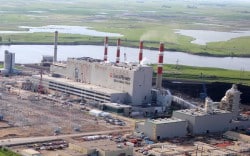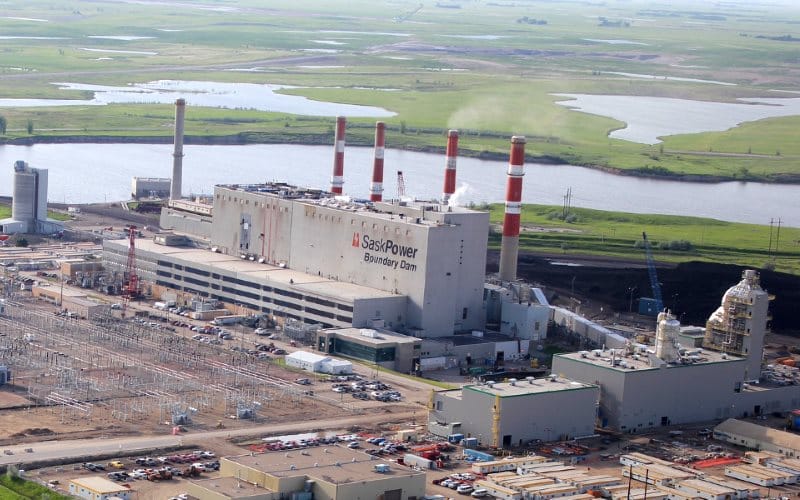
The widely touted ‘carbon capture and storage’ technology is much more expensive than wind and solar, says a Greenpeace report. It also represents a perverse subsidy to the fossil fuel sector that will only boost coal and oil, and delay the transition to a renewable energy system.
A new Greenpeace report, ‘Carbon Capture Scam (CCS): How a False Climate Solution Bolsters Big Oil‘, shows that carbon capture and sequestration (CCS) is significantly more expensive than renewable energy for attempting to reduce carbon pollution.
The technology works by chemically capturing CO2 from the flue gases of power stations, then pumping it to places where it can be pumped underground – either to be stored or, all too often, to force extra oil out of flagging oil fields.
One problem with the technology is that it increases the amounts of fossil fuel that have to be burnt in CCS-fitted power stations by around 30% in order to drive the energy intensive processes. But of course that’s a boon for fossil fuel producers.
“Carbon capture could actually increase the overall climate pollution associated with fossil fuels by promoting increased extraction, combustion, and fugitive emissions”, says Greenpeace.
More than double the cost of wind power
The Greenpeace analysis uses US Energy Information Administration (EIA) cost projections for CCS and renewable energy to calculate relative costs of reducing carbon pollution, and shows how CCS only maintains dependence on fossil fuels and exacerbates greenhouse gas emissions.
Even using EIA’s optimistic assumptions about CCS effectiveness and costs, the report shows that CCS would still cost almost 40% more per kilogram of avoided carbon dioxide than solar photovoltaic, 125% more than wind and 260% more than geothermal.
It calculates that in 2019, based on EIA cost estimates, carbon capture and sequestration would cost 18 cents to avoid the emission of each kilogram of carbon dioxide per unit of electricity, while solar photovoltaics cost 13 cents, wind costs 8 cents, and geothermal costs 5 cents.
And as the cost of renewable energy continues to fall, the advantage of genuinely low carbon technologies like wind and solar will only increase.
“The truth is that carbon capture and sequestration is not worth the investment – sequestration is a gamble while carbon capture does nothing but prop up the oil industry”, said Greenpeace Legislative Representative Kyle Ash.
“Its price tag is further evidence that our focus should be on moving toward affordable renewable energy, not wasting time with false solutions.”
Propping up the oil industry, increasing oil recovery
CCS has been pushed as part of the Obama administration’s ‘all of the above’ energy strategy that has helped maintain our dependence on fossil fuels. The EPA’s proposed carbon rule requires that new coal plants capture CO2, and emphasizes the CO2 be used to augment oil extraction.
Oil rigs then pump the carbon dioxide underground so the oil expands and more is forced up the well. Rather than actually storing carbon, it comes right back up the well with the oil. Every major power plant CCS project in the United States intends to sell the scrubbed carbon to the oil extraction industry.
“There’s a reason that the oil industry is supportive of CO2 capture technology – it makes them more money and maintains our dependence on fossil fuels“, explaiined Ash. “It’s a win-win for coal and oil.
“The coal industry gets to greenwash its image, and the oil industry benefits from the captured carbon that’s harnessed for increasing oil extraction. This scandalous collusion between coal and oil also includes the Obama administration, which is wasting billions in taxpayer dollars on carbon capture while working to expand the extraction of coal, oil and gas.”
The UK government is also keen to progress CCS development and just awarded a £2.5 million contract for the identification of suitable CO2 storage sites.
Insecure carbon storage creates long term hazard
Even if permanent storage was the ultimate goal for the carbon, it has proven to be a dangerous and difficult task.
The locations that have been identified as having the greatest potential for carbon sequestration are in the same spots as fracking and shale gas reserves. Earthquakes as a result of fracking threaten the feasibility of those projects.
Additionally, CO2 can lead to ‘downhole communication’, or ‘frack hits’, in which case the CO2 injected into one hole just comes out another. When it comes to sequestering carbon permanently underground without the complications of oil and gas extraction, the science remains dubious.
A recent MIT study found that the majority of CO2 injected into saline aquifers, the type of geology believed to have the greatest storage potential after exhausted oil wells, could make its way back to the surface.
And in the event of a large-scale release of CO2 from an undergound storage reservoir, which could result from an earthquake or accidental damage, any person or animal caught in the cold, ground-clinging cloud of toxic CO2 gas would die.
The report: ‘Carbon Capture Scam (CCS): How a False Climate Solution Bolsters Big Oil‘.
Background: Greenpeace’s 2014 ‘Energy [R]evolution‘ analysis shows that there is a path to an economy reliant on renewable energy without additional breakthrough technologies or reliance on false solutions like nuclear and CCS. Over the past 15 years, Greenpeace’s Energy [R]evolution analysis has more accurately predicted renewable energy growth than most, including the EIA, International Energy Agency, and others.




